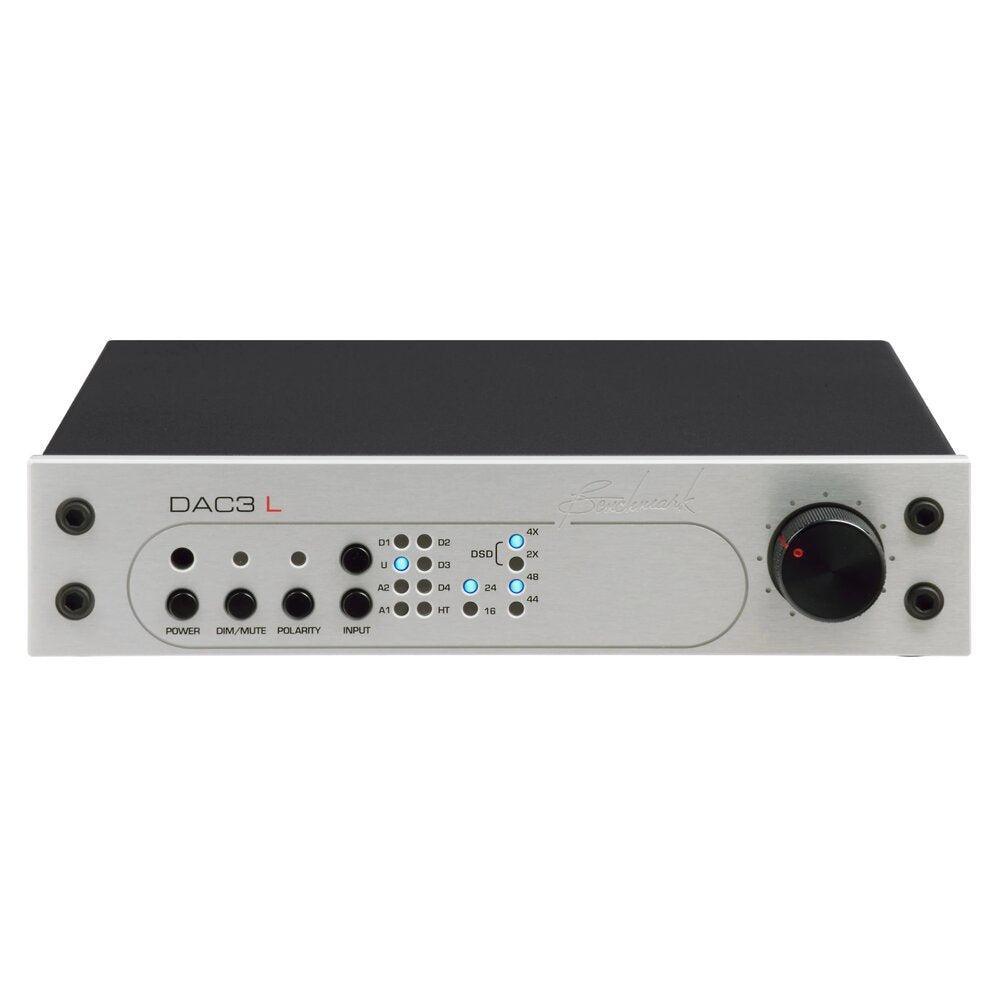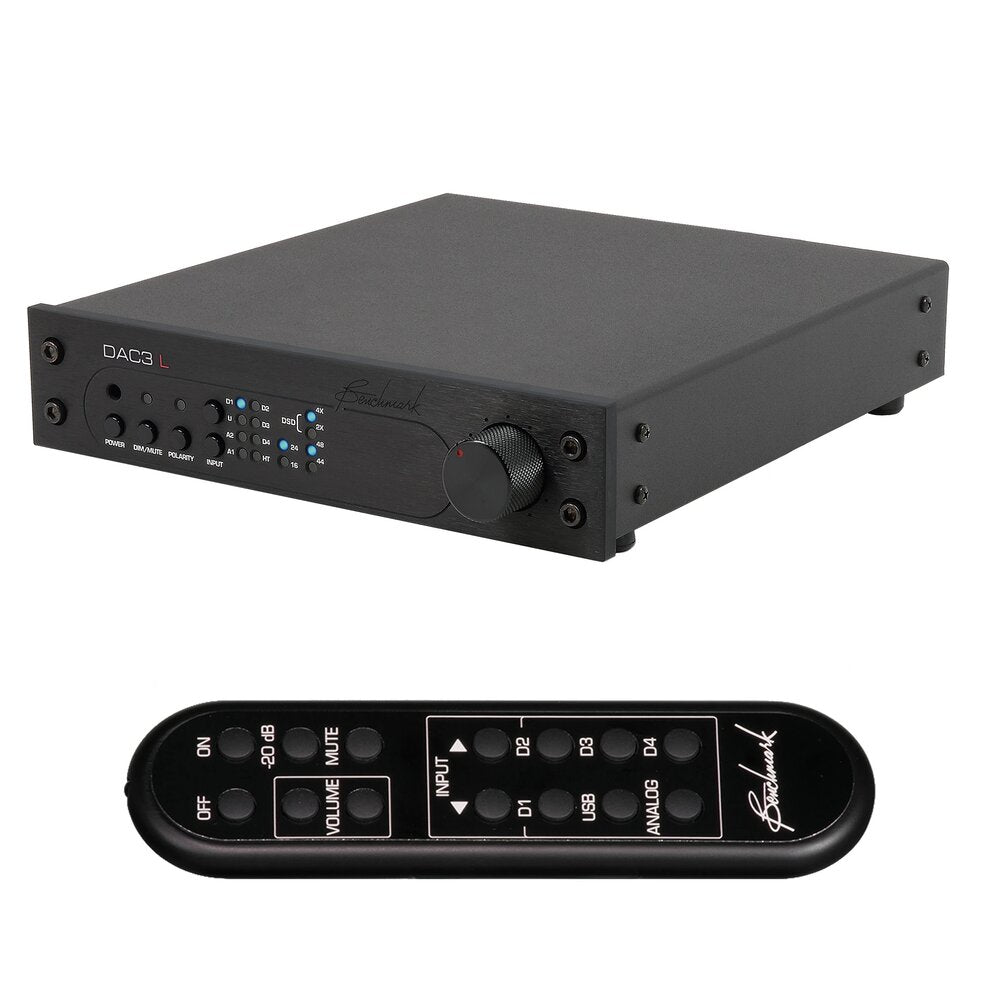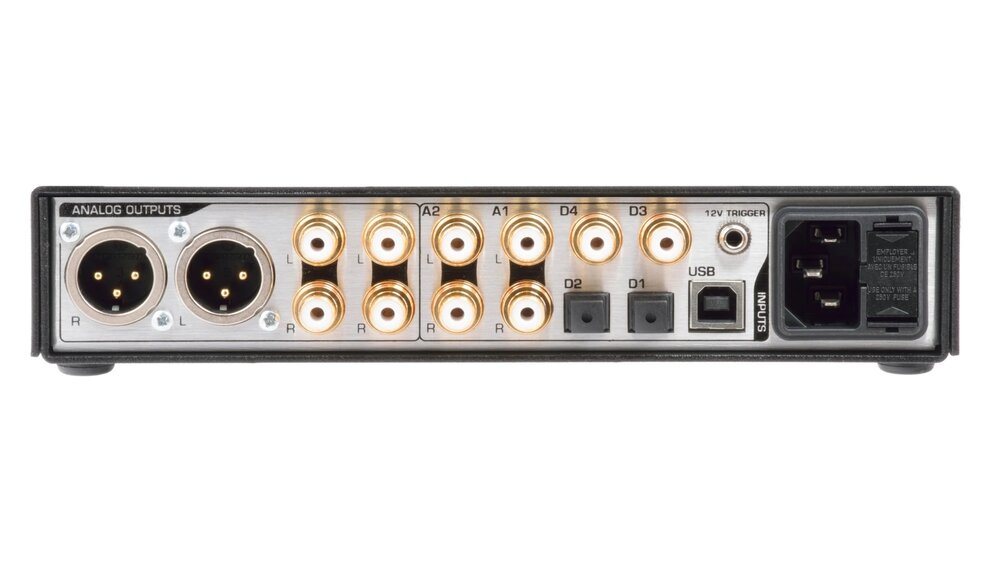Make an Offer

Benchmark DAC3 L - Digital to Analog Audio Converter
Offer Submitted!







Benchmark DAC3 L - Digital to Analog Audio Converter
Benchmark DAC3 L - Digital to Analog Audio Converter
Black
22 Saint Kilda Road
22 Saint Kilda Road
Suite 2.02
St Kilda VIC 3182
Australia



The DAC3 is Benchmark's newest 2-channel D/A converter featuring the new ESS Technologies ES9028PRO converter chip. The DAC3 converter has lower THD and THD+N noise than Benchmark's DAC2 converter.
DAC3 L - Digital to Analog Audio Converter
A New Reference - Going Beyond the Legendary DAC1 and DAC2
The DAC3 is Benchmark's newest 2-channel D/A converter featuring the newESS Technologies ES9028PRO converter chip. The DAC3 converter has lower THD and THD+N noise than Benchmark's DAC2 converter.
Benchmark's DAC1 and DAC2 D/A converter families have been the reference to which other converters have been compared. It is rare to find a converter review that does not draw comparisons to the DAC1 or the DAC2. Benchmark converters are in daily use at many of the world's finest recording studios and mastering rooms. Benchmark converters are also enjoyed by thousands of audiophiles. Benchmark has raised the bar again ... the DAC3 defines a new reference.
Reference Performance
The DAC3 delivers outstanding musical detail and precise stereo imaging. It employs an advanced high-headroom digital filter design, and a high-sample-rate Asynchronous USB Audio interface. All inputs are fully isolated from interface jitter by Benchmark's new UltraLock3™ jitter attenuation system.
Internal digital processing and conversion is 32-bits, and this processing includes 3.5 dB of headroom above 0 dBFS. This headroom prevents the DSP overloads that commonly occur in other D/A converters.
Four balanced 32-bit D/A converters are summed together to create each balanced analog output. This 4:1 summation provides a 6 dB noise reduction, and gives the DAC3 industry-leading performance.
DAC3 vs. DAC2
The DAC3builds upon Benchmark’s highly successful DAC2 product family. The DAC3 maintains the familiar DAC2 form factor and feature set, but adds the higher performance available from the new ES9028PRO D/A converter. The DAC3 offers the following improvements over the DAC2:
-
Active 2nd Harmonic Compensation
-
Active 3rd Harmonic Compensation
-
Lower THD+N
-
Lower passband ripple
-
Improved frequency response
-
Faster PLL lock times
-
Faster switching between input signals
DAC3 vs. DAC1
The DAC3 and DAC2 added these features that were not found on the DAC1:
-
Asynchronous 192kHz USB Audio 2.0
-
32-bit D/A conversion system
-
Word Length Display
-
Sample Rate Display
-
Polarity Control
-
Direct DSD D/A Conversion
-
-20 dB DIM
-
Bi-Directional 12V Trigger
-
Power Switch with Auto-On Function
-
Home Theater Bypass
-
Digital Pass-Through
-
High-Headroom DSP
-
Dual-Domain Hybrid Gain Control
-
Additional I/O
Native DSD Conversion
All digital inputs on the DAC3 support native 192 kHz PCM or DSD64 conversion. From any input, DSD is transported with bit accuracy over DoP 1.1. DSD and PCM are both natively converted to analog. There are no DSD to PCM or PCM to DSD conversions to compromise the quality of the music. The DAC3 conversion system seamlessly switches between native PCM and native DSD conversion. DSD over DoP 1.1 is supported by many media players, and DSD downloads are now available from several sources.
Direct Connectivity to Power Amplifiers
Benchmark DAC1, DAC2, and DAC3 converters are designed to directly drive power amplifiers and speakers. Benchmark converters feature adjustable low-impedance passive attenuators at the XLR outputs that can be used to optimize the interface to the power amplifier (or powered monitor). This unique Benchmark feature optimizes the gain staging between the DAC and the power amplifier. Proper gain staging cannot be overemphasised. When audio stages are properly matched, each component in the audio chain is able to operate at its optimum signal level, and the system performance is significantly improved.
Sonically-Neutral Studio Monitoring
All Benchmark converters are designed for maximum transparency. This transparency is absolutely essential in the studio monitoring chain. For this reason, DAC3 converters are ideal for critical reference-quality professional systems. Unlike many competing products, the DAC3 is not designed to add "euphonic" coloration to the audio. Instead it is designed to be as uncolored and natural as possible.
Step Into the Studio
When Benchmark's professional converters are used in hi-fi applications, studio-quality sound can be enjoyed in a home environment. Enjoy pure music without any coloration from the electronics. Hear the music exactly the way it was heard in the studio, and exactly the way the artists intended.
Discover the natural, uncolored, analog sound of the DAC3.
Sit in the Performance Space
Transparent sound can go beyond replicating the studio experience. Recordings that have been produced with a natural and unprocessed sound can transport you to the performance space. But, this can only happen when the entire playback chain is selected for maximum transparency.
This experience of "being there" cannot be created by systems that are designed to add "warmth" or "euphonic color" to the music.
Important Features
-
Sample Rate Display
-
Word Length Display
-
5 Digital Inputs
-
2 Stereo Analog Inputs (2 RCA)
-
3 Stereo Analog Outputs (2 RCA, 1 XLR)
-
Digital Pass Through
-
Native DSD Conversion
-
Polarity Switch
-
Asynchronous USB 2.0
-
Driverless Asynchronous USB 1.1
-
Home Theater Bypass
-
Bi-Directional 12 Volt Trigger
-
Power Switch
-
Low Power Consumption
-
ES9028PRO Converter
DESIGNED, ASSEMBLED, AND TESTED IN THE USA
This Benchmark product was designed, assembled, and tested in the USA using USA and imported components. Most major components are made in USA.
|
Audio Performance |
|
|
Fs = 44.1 to 96 kHz, 20 to 20 kHz BW, 1 kHz test tone, 0 dBFS = +24 dBu (unless noted) |
|
|
SNR – A-Weighted, 0 dBFS = +27 dBu |
128 dB |
|
SNR – Unweighted, 0 dBFS = +27 dBu |
126 dB |
|
THD+N, 1 kHz at 0 dBFS |
-113 dBFS, -113 dB, 0.00022% |
|
THD+N, 1 kHz at -1 dBFS |
-114 dBFS, -113 dB, 0.00022% |
|
THD+N, 1 kHz at –3 dBFS |
-119 dBFS, -116 dB, 0.00016% |
|
THD+N, 20 to 20 kHz test tone at –3 dBFS |
-113 dBFS, -110 dB, 0.00032% |
|
Frequency Response at Fs=192 kHz |
+0 dB, -0.015 dB (20 to 20 kHz) -0.015 dB at 10 Hz -0.005 dB at 20 kHz -0.031 dB at 40 kHz -0.15 dB at 80 kHz |
|
Frequency Response at Fs=48 kHz |
+0 dB, -0.015 dB (20 to 20 kHz) -0.015 dB at 10 Hz -0.005 dB at 20 kHz |
|
Crosstalk |
-137 dB at 20 Hz -130 dB at 1 kHz -116 dB at 20 kHz |
|
Maximum Amplitude of Jitter Induced Sidebands (10 kHz 0 dBFS test tone, 12.75 UI sinusoidal jitter at 1 kHz) |
< -144 dB |
|
Maximum Amplitude of Spurious Tones with 0 dBFS test signal |
< -138 dB |
|
Maximum Amplitude of Idle Tones |
< -147 dB |
|
Maximum Amplitude of AC line related Hum & Noise |
< -133 dB |
|
Inter-channel Differential Phase (Stereo Pair – any sample rate) |
+/- 0.25 degrees at 20 kHz |
|
Inter-channel Differential Phase (Between DAC3 Units Fs<110 kHz) Any sample rate. |
+/- 0.25 degrees at 20 kHz |
|
Maximum Lock Time after Fs change |
6 ms |
|
Soft Mute Ramp Up/Down Time |
9.6 ms |
|
Mute on Receive Error |
Yes |
|
Mute on Lock Error |
Yes |
|
Mute on Idle Channel |
No |
|
50/15 us De-Emphasis Enable |
Automatic in Consumer Mode |
|
De-Emphasis Method |
Digital IIR |
|
De-Emphasis Supported at |
Fs = 32, 44.1, 48 kHz |
|
Group Delay (Latency) |
|
|
Delay – Digital Input to Analog Output (function of sample rate)
|
1.36 ms at 44.1 kHz 1.27 ms at 48 kHz 0.90 ms at 88.2 kHz 0.82 ms at 96 kHz 0.51 ms at 176.4 kHz 0.47 ms at 192 kHz |
|
Digital Audio Inputs |
|
|
Number of Digital Inputs (switch selected) |
5 (1 USB, 2 Optical, 2 Coaxial) |
|
Number of Channels |
2 |
|
Input Sample Frequency Range |
28 to 210 kHz (Coaxial Inputs) 28 to 96 kHz (Optical Inputs) 44.1, 48, 88.2, 96, 176.4, 192 kHz (USB Input) |
|
Maximum Input Word Length |
24 bits |
|
Digital Input Impedance |
75 Ohms (Coaxial Inputs) |
|
DC Blocking Capacitors on Digital Inputs |
Yes (Coaxial Inputs) |
|
Transient and Over-Voltage Protection on Digital Inputs |
Yes (Coaxial Inputs) |
|
Minimum Digital Input Level |
250 mVpp (Coaxial Inputs) |
|
Jitter Tolerance (With no Measurable Change in Performance)
|
>12.75 UI sine, 100 Hz to 3 kHz >1.5 UI sine at 20 kHz >1.5 UI sine at 40 kHz >1.5 UI sine at 80 kHz >1.5 UI sine at 90 kHz >0.25 UI sine above 160 kHz |
|
Jitter Attenuation Method |
Benchmark UltraLock3™ - all inputs |
|
Balanced Analog Outputs |
|
|
Number of Balanced Analog Outputs |
2 |
|
Output Connector |
Gold-Pin Neutrik™ male XLR |
|
Output Impedance |
60 Ohms (Attenuator off) 425 Ohms (Attenuator = 10 dB) 135 Ohms (Attenuator = 20 dB) |
|
Analog Output Clip Point |
+30 dBu |
|
Factory Set Bypass Level (at 0 dBFS) |
+24 dBu (Attenuator = 0 dB) |
|
Output Level Range (at 0 dBFS) In ‘Variable’ Mode |
Off to +27.5 dBu (Attenuator off) Off to +17.5 dBu (Attenuator = 10 dB) Off to +7.5 dBu (Attenuator = 20 dB) |
|
Output Level Variation with Sample Rate (44.1 kHz vs. 96 kHz) |
< +/- 0.006 dB |
|
Unbalanced Analog Outputs |
|
|
Number of Unbalanced Analog Outputs |
4 |
|
Output Connector |
RCA |
|
Output Impedance |
30 Ohms |
|
Analog Output Clip Point |
+13.5 dBu (3.7 Vrms) |
|
Factory Set Home Theater Bypass Output Level (at 0 dBFS) |
+8.2 dBu (2 Vrms) |
|
Output Level Range (with 0 dBFS digital input) |
Off to +11.7 dBu (3 Vrms) |
|
Output Level Variation with Sample Rate |
< +/- 0.006 dB |
|
Status Display |
|
|
Indicators - Type and Location |
16 LED’s on Front Panel |
|
Selection/Status Indication |
1 – Dim/Mute 1 - Polarity |
|
AC Power Requirements |
|
|
Nominal Input Operating Voltage Range (VAC RMS) |
100 – 240V |
|
Frequency |
50-60 Hz |
|
Power |
< 0.5 Watts Idle |
|
Fuses |
5 x 20 mm (2 required) |
|
Min/Max Operating range (VAC RMS) |
90 – 260 VAC |
|
Dimensions |
|
|
Form Factor |
½ Rack Wide, 1 RU High |
|
Depth behind front panel |
8.5” (216 mm) |
|
Overall depth including connectors but without power cord |
9.33” (237 mm) |
|
Width |
9.5” (249 mm) |
|
Height |
1.725” (44.5 mm) |
|
Weight |
|
|
DAC3 only |
1.36kg. |
|
DAC3 with remote control, power cord, extra fuses, and manual |
1.81kg. |
|
Shipping weight |
3.1kg. |
User Reviews
We care about your experience with HeyNow Hi-Fi, and we’re here to make the warranty process as smooth as possible.
Your warranty is handled directly by the Australian importer. By submitting this form, we’ll coordinate the process for you and keep you updated every step of the way. Important: Shipping fees are not included as part of your warranty coverage.
If your HeyNow Hi-Fi purchase isn’t working as it should, click here to lodge a warranty claim.
Should you have any questions, feel free to contact us https://www.heynowhifi.com.au//pages/contact



